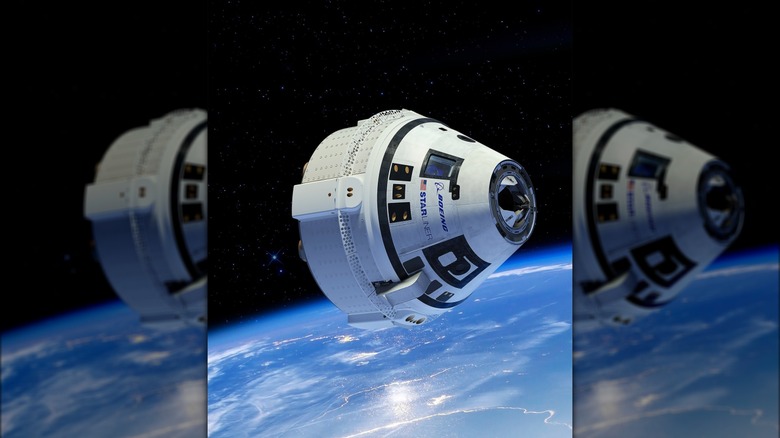Here's How The Astronauts Stuck In Space On The Boeing Starliner Will Survive
It's an absurd understatement to say that space flight comes with risks. Human bodies were meant to laze around on the grass a bit, maybe pick some fruit, go on a little forest jaunt, and so forth. If one single thing goes wrong in space it could spell absolute doom. Or in the case of the recent Boeing Starliner mission, it could mean being stuck in orbit — perhaps until 2025.
On June 5 the Starliner and its scant two-person crew, Suni Williams and Butch Wilmore, blasted off to the International Space Station (ISS) as part of a short, eight-day mission. As NASA explains, the mission was supposed to be a test run of Starliner, a craft designed for reusability, cost-saving, and time-saving. After doing a check of the Starliner's launch pad, rocket, flight capabilities, etc., the craft was set to come back to Earth — easy-peasy. But as the BBC explains, there was a helium leak on launch day that got hand-waived and then got much worse. And since helium is used for maneuvering and slowing descent during reentry, Williams and Wilmore are basically stranded until the whole thing gets analyzed.
Or as People quotes NASA program manager Steve Stich said, Williams and Wilmore are "not stranded." They could return at any time but are being cautious and opting for the safest route home. In the meantime, things aren't exactly as dramatic as a Hollywood disaster movie. The astronauts are hanging out on the ISS, gathering data, and getting regular supplies, to boot.
[Featured image by NASA/Isaac Watson via NASA| Cropped and scaled | NASA Media Usage Guidelines]
A test run of a new, reusable spacecraft
In a way, astronauts Suni Williams and Butch Wilmore have already fulfilled the purpose of their trip: to do a test run of the viability and safety of the Boeing Starliner craft. They were willing guinea pigs, in other words. And now, as the BBC explains, they want to investigate what went wrong from a safe location inside the International Space Station (ISS). It's not that the Starliner runs the risk of spontaneously erupting on reentry, but rather without the benefit of helium to slow their descent to Earth the part of the craft that failed — the "service module" — will burn up and get destroyed. It'd be impossible to check what went wrong at that point. And so, Williams and Wilmore are gathering data now. This might take months, even until 2025.
This is all a bit ironic given how long it took to get the current mission off the ground, so to speak, and all the hopes pinned on it. The Boeing Starliner — more properly the CST-100 Starliner — is a cutting-edge product with nifty features like crewless flight, a weldless design, built-in tablets, etc. Each craft is designed to support 10 total missions with a six-month turnaround, back and forth to the ISS like a transport vessel. It was also originally intended for a 2017 launch but faced a bunch of delays. NASA has a huge compendium of dedicated information about the mission and vessel on its website.
[Featured image by NASA/Frank Michaux via NASA| Cropped and scaled | NASA Media Usage Guidelines]
High hopes for an untroubled return
To be clear, astronauts Suni Williams and Butch Wilmore aren't freaking out and about to die. Nor are they or anyone else involved in the mission really concerned in the slightest. Per the BBC, Williams and Wilmore are "absolutely confident" that they'll make it home, no problem. They even commented that the Starliner was "truly impressive," no matter the helium malfunction this time around. And as stated, the astronauts aren't confined in the tiny, conical Starliner capsule that's just about big enough for some seats and built-in equipment. They're on the International Space Station (ISS), which astronaut Victor Glover on the BBC describes as a "seven-bedroom, three-bathroom ensuite."
While Williams and Wilmore go about their business they've received shipments of extra clothes, extra food, extra "consumables," as the BBC says, and so forth. Water is no problem. In other words, they're "happy as clams," as BBC quotes editor Ken Kremer. Plus, they still might be able to use the Starliner to come home. This would be good for the families of the astronauts, especially Wilmore, who has two daughters. And if not the Starliner, Space.com says that the duo might hitch a lift with the SpaceX Dragon. It all depends on if NASA thinks the Starliner is safe enough.
NASA is also broadcasting a live, audio-only teleconference with Williams and Wilmore on August 14. Depending on how much longer the astronauts stay up on the ISS, it might not be the last broadcast of its kind.
[Featured image by Boeing via NASA| Cropped and scaled | NASA Media Usage Guidelines]


